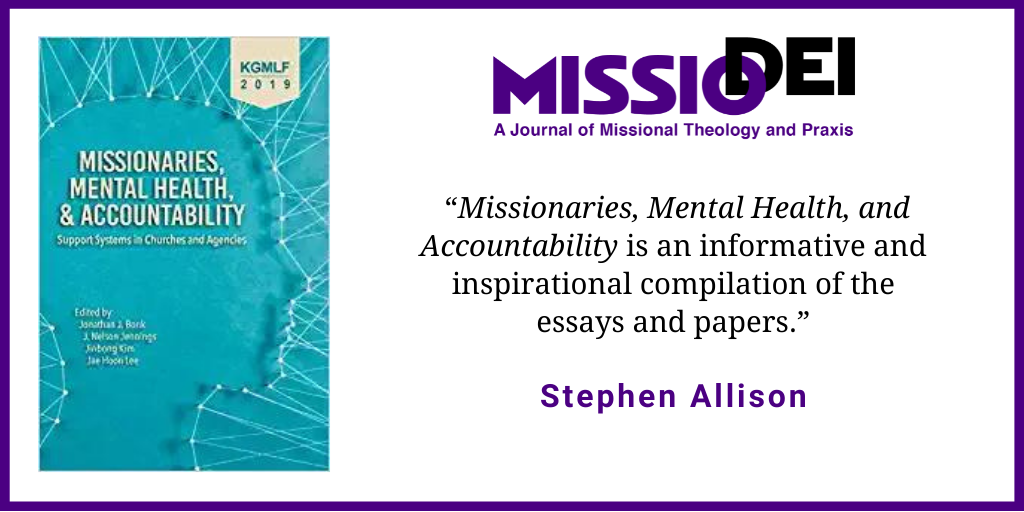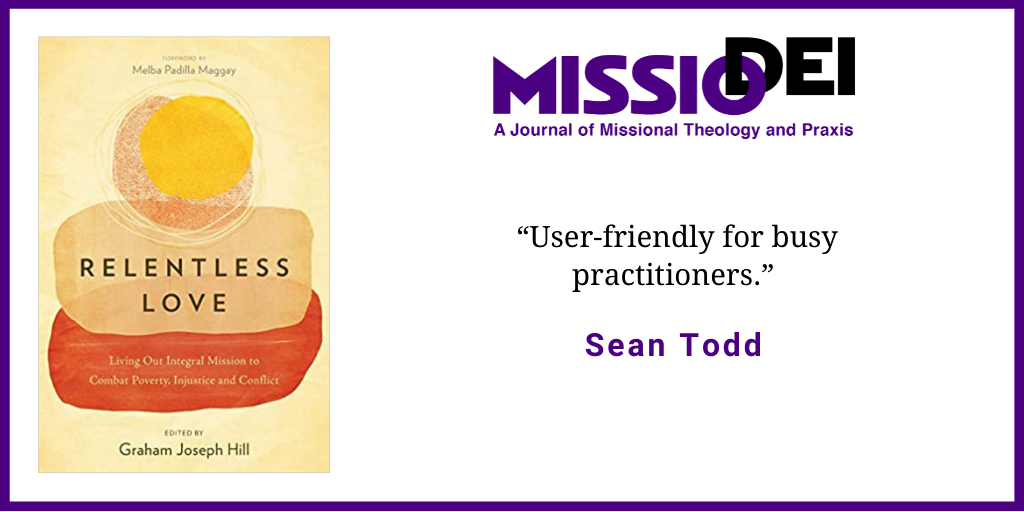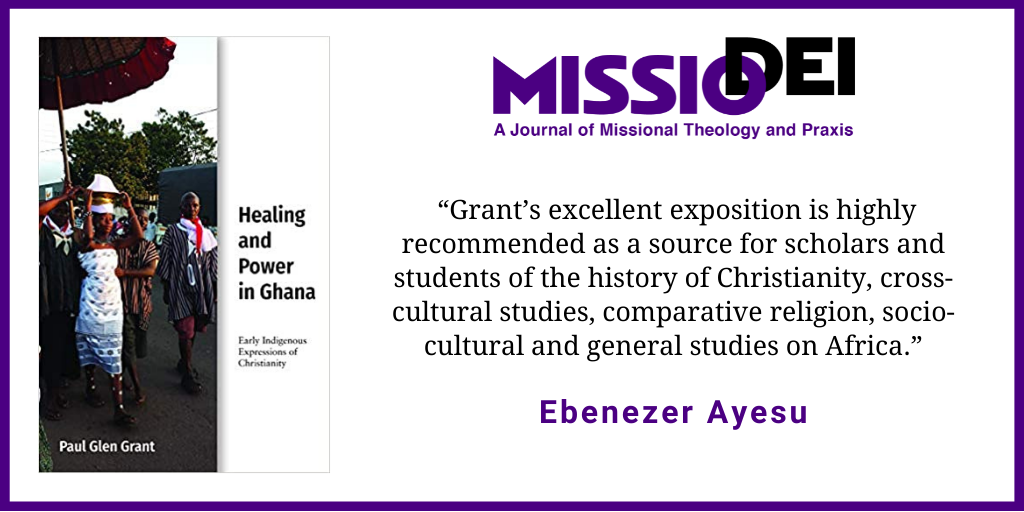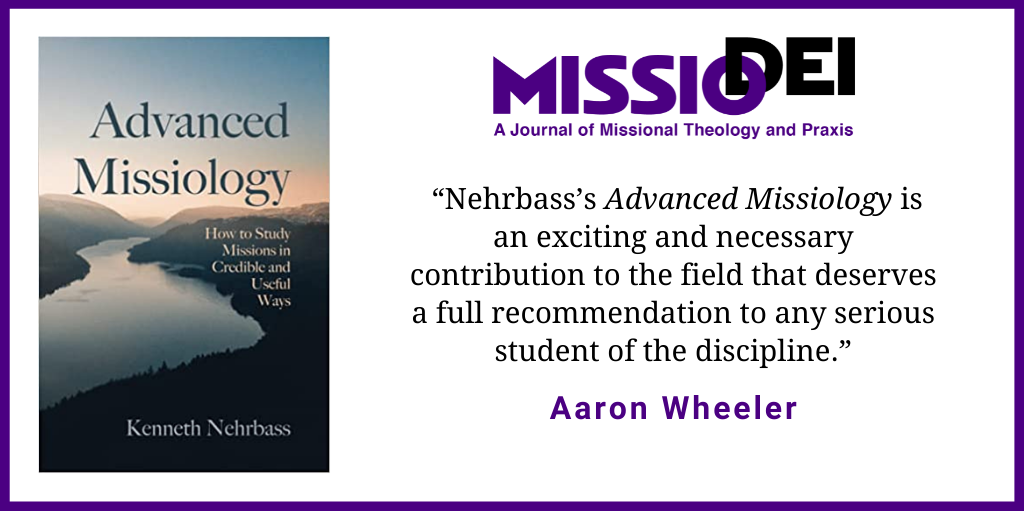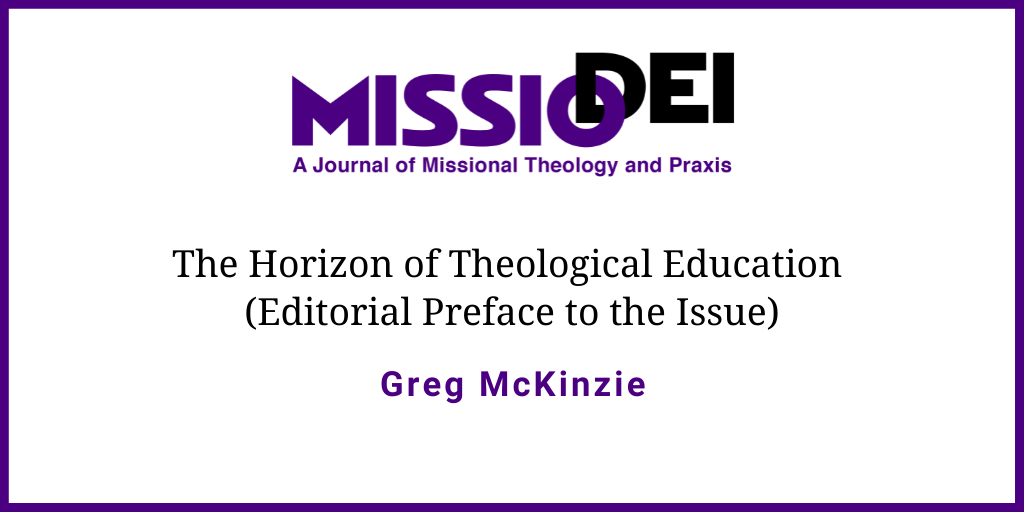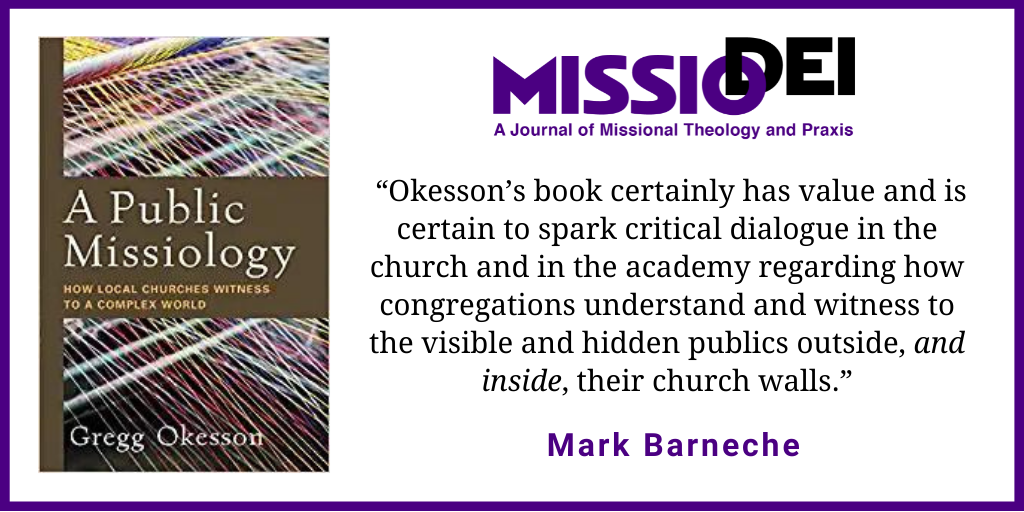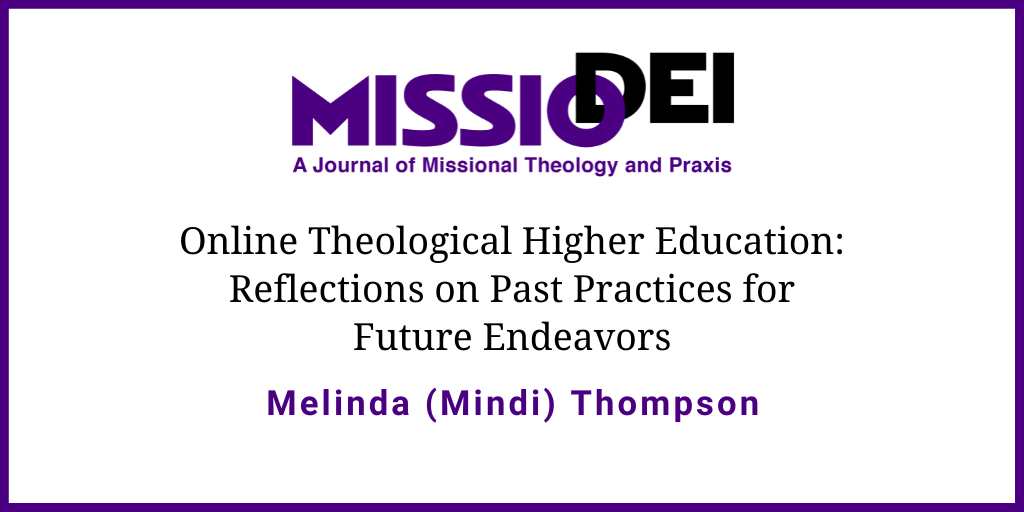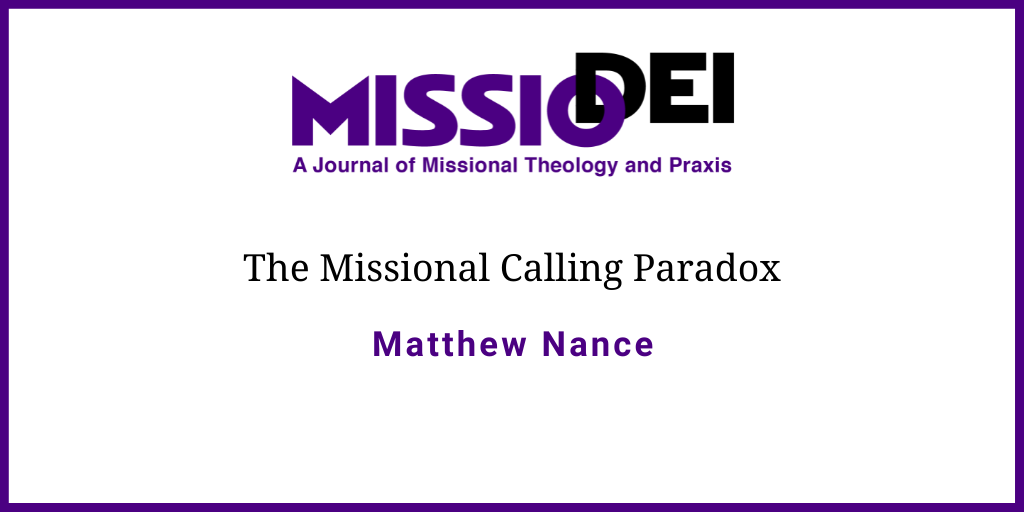
This paper discusses the primary data produced in an initial round of interviews inquiring into the relationships between expatriate missionaries and native pastors in the country of Jordan. This research is being conducted as part of the PhD program I am completing at Oxford Centre for Mission Studies (Oxford, UK). These interviews revealed a possible correlation between individual conceptualizations of personal calling and the health of future ministry relationships. This paper argues the “paradox of missional” is that a phenomenon generally understood as healthy may present obstacles to mutuality in mission partnerships.
Nick grew up in a Christian home and went to a church summer camp during his second year in high school. During the camp, a missionary spoke to the youth every night about his ministry and the need to reach the “unreached” with the gospel. He told the campers that over a billion people had not heard the gospel and would go to hell unless someone came to tell them. Nick felt burdened by this and began praying for “the lost”; he also began reading and learning more about missions. He learned that one area of the world with the most need was the Middle East. While many people in his home country were scared of Muslims, Nick began to feel attracted to the exciting and mysterious mission field that might await him. Soon he was confident that he was “called” to missions among Muslims. He shared this with his home church, and many voiced their support. Nick attended a Bible college and spent a summer in Morocco. His affection for Muslims only increased as he learned the local language and experienced their hospitality. After college, he applied to a missions organization that specialized in “unreached fields.” After acceptance, he went through several trainings in evangelism and church planting among Muslim people. Nick left for Jordan sure of his calling to share the gospel among Muslims; he dreamed of a future of seeing his converts launching out to share the gospel and plant churches of their own. After settling into his new home, Nick learned of a small evangelical church in his neighborhood. Excited to meet local Christians, he visited, was welcomed, and was even invited by the pastor, Yusuf, to his home for a meal.
Yusuf also grew up in a Christian home in Amman, Jordan, and from an early age became aware of his family’s proud heritage as Arab Christians. “Our ancestors were present at Pentecost!” his grandfather proclaimed. Yusuf also grew up going to church camp where he learned that Arab Christianity was under threat and that his generation might be the last to live in their homeland, as so many Christians were emigrating. Yusuf was bullied in school because of his Christian identity. He became aware that Christians were often treated as second-class citizens by the Muslim majority. His grandfather’s stories influenced Yusuf. Consequently, he decided he did not want to emigrate like other friends and family members; he felt that God was calling him to become a pastor and care for his people as they struggled to exist and stay true to their faith in their homeland.
When Yusuf invited Nick to share a meal, he was excited to demonstrate the Arab Christian tradition of hospitality and get to know a new potential church member. Nick shared that he had come to Jordan to evangelize Muslims and had high hopes for the future. Yusuf shared that the church was struggling to hang on, and most church members had negative experiences with Muslims, were scared to evangelize, and had limited resources to fund outreach. Yusuf had relationships outside the church with Muslim background believers but feared bringing them into the church would invite more persecution, so he discipled them privately and secretly. Yusuf had some ideas for ministry projects that could bless church members he wanted to share with Nick, and Nick was excited to enlist Yusuf’s church in his evangelistic plans.
However, following the meeting, Nick felt that the Arab church was not interested in helping him towards his calling of evangelizing Muslims. On the other hand, Yusuf felt that Nick cared more about Muslims than his Christian brothers and sisters. Nick felt that Yusuf was closed-minded, and Yusuf felt that Nick was too caught up in his plans. They maintained casual contact for the next few years but never achieved a deep personal or ministry partnership. Furthermore, they never became close friends. Eventually, Nick and his family left Jordan after seeing a few individuals convert but coming short of the widespread movement of which he dreamed. Yusuf and his small church are still trying to survive; a couple more move away every year.
Introduction
The research discussed in this paper looks at mission partnerships in Jordan between foreign evangelical missionaries and their local Arab counterparts. The problem identified is a breakdown in the formation and practice of mission partnerships primarily due to each party’s insufficient relational basis in missional partnerships. Local Jordanian churches have built cooperatives amongst themselves, and there are several examples of successful collaboration in the community of expat workers. However, cross-cultural mission partnerships between foreign missionaries and local believers have been weak and problematic.
For eight years, I ministered in Jordan and maintained membership in a local Jordanian evangelical church. During this time, I continually observed foreign missionaries and Jordanian Christians struggling to relate to each other and collaborate in shared ministry endeavors. I have experienced a range of successes and frustrations in my personal and ministry relationships in Jordan. Further, many missionaries are choosing to pursue their mission goals outside of a relationship with local Christians, and conversely, many local congregations are hesitant to fully welcome missionaries into their congregation. Only one of the five missionaries I interviewed regularly attends an Arabic-speaking church service. One Jordanian pastor, the district supervisor of his denomination, remarked that “Missionaries are not much of a help to us.”
My research in the mission studies literature and an initial round of interviews in Jordan revealed four major components of mission partnership: (a) calling, (b) perceptions and memories of the other, (c) power dynamics, (d) mission goals. This paper, however, limits itself to discussing the theme of missional calling.
My research has shown that missional calling arising from personal experience is a dominant impetus in forming missional partnerships. The experience of calling to mission often predates, by years, practitioners’ entry into the mission field. Yet this calling informs and molds their understanding of missional partnerships even before establishing their first missional relationship. Relational considerations have become subservient to the fulfillment of personal calling. The concept of calling is a dominant theme that emerged from interviews. While a common perception may assume that a clear missional calling will result in relationships that form healthy partnerships, it appears that individual calling to mission often stands in the way of building healthy relationships that result in successful partnerships. Thus, the paradox identified is that the missional calling experience commonly understood as foundational and helpful can result in paradoxically unhealthy and unsuccessful relationships.
This research is timely because Christianity in the Middle East continues, in most places, to decline as a percentage of the overall population. In Jordan, Christians equaled 9% of the population in 1952 and 2.2% in 2011. Lebanese Christian academic George Sabra writes that the future of Arab Christianity looks “bleak.” And that foreign missionaries must support and cooperate with local believers rather than circumvent them: “Mission to the Middle East must support and cooperate with the Christians of the region, not bypass them.” Sadly, the legacy of twentieth-century Western missions to the Arab world may be dominated more by the resultant divisions of the Christian community rather than the intended conversion among Muslims. I have witnessed that partnership between foreign missionaries and Arab Christians is a complex and difficult endeavor. My conversations over the past eight years have revealed that both sides are willing to form partnerships, and they feel that ministry in partnership would be ideal but is not the reality. In other words, the current model and understanding of partnership in mission are not sufficient to inform mission practice in Jordan.
Partnership
Since the early 1900s, the mission community has become increasingly aware of the persisting ill-effects of the colonial era in which mission was often synonymous with the imposition of Western cultural preferences, resulting in paternalism and dependency. With the end of the colonial era, the mission community sought to redefine the relationship between the older and younger churches. “Partnership” became the popular term to speak of a “new relationship between the ‘South’ and the ‘North’ in terms of mutual covenant and reciprocal cooperation.” This definition, from Samuel Cueva, has two components that I find helpful. First, that mission partnership is a “mutual covenant,” speaks to the nature and quality of the relationship. The idea of covenant is central to mission: “One specific way that God pursued his mission was by making a covenant with his people to make himself known to them.” Therefore, the covenant relationship between Christians in mission follows the covenant relationship between God and his people in pursuit of his mission. A covenant relationship is committed, loyal, and gracious. A theological understanding ties the relationships Christians have with one another to their relationship with God. Second, Cueva speaks more practically: a mission partnership engages in “reciprocal cooperation.” In mission partnership, believers from different backgrounds collaborate and give to each other. Kirk picks up on this: “Within world Christianity, ‘partnership’ expresses a relationship between churches based on trust, mutual recognition, and reciprocal exchange. It rules out completely any notion of ‘senior’ and ‘junior,’ ‘parent’ and ‘child,’ or even ‘older’ and ‘younger.’ It is a term designed to show how different parts of the Church belong to one another and find their fulfillment through sharing a common life.” A three-fold understanding of mission partnership as theological, relational, and practical is a helpful framework for this research.
Partnership in mission addresses a theological understanding of believers from different cultures and ethnic backgrounds relating together in unity. Partnership is, therefore, not a nice slogan that some clever committee has dreamt up; it is the expression of one, indivisible, common life in Jesus Christ. In mission, the functional aspects of partnership must build on a more profound commitment to living and ministering in partnership. In the former, completing a task is paramount; in the latter, it is the biblical call to unity. A commitment to and practice of mutual relationships ought to then see mission initiatives co-birthed through healthy partnerships.
The mission community has been talking about partnership for a century, but old habits persist, and many relationships are trying to achieve the ideals of partnership. Walls relates that “the original organs of the missionary movement were designed for one-way traffic; for sending, for giving. Perhaps there is now an obligation of Christians to ‘use means’ better fitted for two-way traffic, fellowship, for sharing, for receiving, than have yet been perfected.” Kirk is more direct than Walls: “Partnership is a great idea; pity about the practice!” We must recommit ourselves to struggling towards missional covenant relationships.
Martin Buber’s Theory of Relationship
Martin Buber’s work on relationship and dialogue as a philosophical lens is highly useful for inquiry on mission partnerships. He presents a model of relationship that can lead to wholeness, mutual learning, and genuine collaboration. Buber proposed that human existence is only defined by how we relate to other humans, creation, and God. He believed in two types of dialogical relationships defined by two basic attitudes a person can take. He used what he calls “basic words” to describe these two attitudes: “I-it” and “I-thou.” “I-thou” designates a relation between subject and subject in reciprocity and mutuality. “I-it” is a subject-object relationship of utilization or control, the object being wholly passive. Newbigin explains, “it is the difference between two ways of understanding the world, one in which the self is sovereign and the other in which I understand myself only in a relation of mutuality with other selves.” This dichotomy of mutuality vs. control is a central problem in the mission partnership discussion.
In contemporary mission literature, mutuality arises as a major theme concerning mission partnerships. Various authors propose that the way forward in post-colonial missions is to develop relationships between expat and local Christian mission workers that respect each other’s contributions, abilities, customs, and thoughts. These authors and our experiences also admit that the practice of mission partnership often does not live up to such ideals, and an unequal power dynamic often persists. Therefore, a relationship that most agree should be defined by mutuality is, in practice, non-mutual. I believe that Buber, therefore, is useful as this research seeks a foundational understanding of relationship in mission contexts. Although Newbigin’s explicit use of Buber has already brought Buber into the mission studies discourse, there remains little systematic engagement of Buberian thought in the discipline. Further, it is not out of place to use Buberian thought within the context of cross-cultural work because Buber himself was involved in dialogue between Jews, Christians, and Muslims in Israel/Palestine.
Relationship with Oneself
For Buber, the “basic words” fundamentally determine first the nature of one’s relationship with his or herself. For him, these basic words are central to one’s self. They are “primal,” “Basic words are spoken with one’s being.” Hence, while the second word of the pair changes, the I is different in orientation between the pairs. In Buber’s view, one always engages the world from one of these primal stances towards others. That stance defines oneself rather than the other. “I” can only understand myself in relation to others being either a “you” or an “it”: “There is no I as such but only the I of the basic word I-You and the I of the basic word I-It.” For Buber, a person is defined by relation to others. However, he admits that all people exist in a dynamic interplay between these attitudes.
If we take a stance that human beings are inherently relational, any study of mission partnership must, therefore, begin with the self and the factors it perceives to have defined itself. If I have to identify an idea that would serve as a base for a theology of partnership, it would be our intrinsic relatedness within the web of life. Relationship is our fundamental reality. In the beginning, is relationship. Relationship is constitutive of who we are and of what we can become. In trying to understand partnership, we realize that we first must understand the self and its orientation as it enters into relationship.
Understanding the Other
An I-It relationship meets the other in a subject-object transactional nature. The other person is an It. They are a means to meeting one’s needs and pursuing one’s priorities. The I engages in a monologue whereby they are in control and not changed by the relationship. Its functional role defines the relationship. Lingenfelter describes a case of a dysfunctional partnership between African and American mission partners he was called in to consult on: “Each of these partners was more focused on achieving the ends that each had for partnership than on developing effective relationships together.” Lingenfelter has described an I-It relationship dictated by a subject-object attitude. He has also identified Buber’s counter-argument, dialogue, through “developing effective relationships together.” Assuming an I-Thou attitude engages one in a mutual connectedness with the other. Buber explains, “The basic word I-You can only be spoken with one’s whole being. The basic word I-It can never be spoken with one’s whole being.” This attitude is subject-to-subject and does not limit oneself to specific and limited traits. It acknowledges that each is a dynamic being only known wholly through dialogue and wholly opening oneself.
Newbigin uses Buber to answer the epistemological question of how we know God and other people. Newbigin warns against an attitude that approaches others as objects to be studied and analyzed. Taking a Buberian I-Thou attitude, he relinquishes the control of modernity and attributes Buber as clarifying to him the difference between reason and revelation in relationships: “The difference is not between the use of reason and its abandonment; it is the difference between two ways of understanding the world, one in which the self is sovereign and the other in which I understand myself only in a relation of mutuality with other selves.” For him, “the posture of humble and submissive listening is appropriate.” He does not reject reason but makes it subject to a mutual relationship in which the other also has a voice and equal contribution.
Relationship with the Other
A discussion on letting others into our lives can lead to the vocabulary of hospitality. To Westerners, hospitality generally evokes visions of inviting friends and guests to our home for a meal or party. In Arab culture, hospitality is a core cultural value: “The value of hospitality is impressed upon Arab children from an early age.” Arab culture generally sees hospitality as an extension of generosity, a social guard against the accumulation of wealth, and a division between rich and poor. A Christian concept of hospitality, however, is rooted in the conviction that God, through Christ, has invited humanity into his fellowship. The proper response is for Christians to extend this invitation to others, even to strangers and those who could not repay it. Russell defines hospitality as the practical embodiment of this truth: “I understand hospitality as the practice of God’s welcome, embodied in our actions as we reach across differences to participate with God in bringing justice and healing to our world in crisis.” Practicing hospitality opens up one’s life to another and, in a state of vulnerability, says, “I need you too.” We stop seeing others as objects and see them instead as fellow subjects. This is a useful way of approaching our understanding of power in relationships and partnerships. To Koenig, hospitality is “partnership with strangers,” and for him, even those we know become “strangers” as we open ourselves to them, and they to us, we see each other in new ways. Inviting others in genuine hospitality is “the catalyst for creating and sustaining partnerships in the gospel.” While arguing against false hospitality that perpetuates a colonial hold on power, Letty argues that “hospitality” is reframed “as a form of partnership with the ones we call ‘other,’ rather than as a form of charity and entertainment.” As a theologically driven practice, hospitality opens one to another and forms the basis and means of a mutual relationship that breaks down traditional power barriers.
In Buber’s understanding, an I-Thou attitude positions one to give and receive, change and be changed by the other. “Relation is reciprocity.” Approaching another as an object constrains and controls within the limits of oneself. “Rather than serving as an object of experience, ‘Thou’ points to the quality of genuine relationship in which partners are mutually unique and whole.” Taking an I-Thou attitude into mission partnership expects and works for a relationship with other whole persons, not just a means of achieving one’s goals.
Relationship with God
Of course, mission partnership has a goal: participation in the mission of God. Newbigin keeps this discussion of relationship on track by arguing that “we cannot be Christ’s ambassadors, beseeching all men to be reconciled to God, except we ourselves be willing to be reconciled one to another in Him.” Participation in God’s mission demands that Christians live in unity with each other in relationship with God. A relational model of mission subordinates the perceived task to participation in a holy relationship, first with God and then with each other.
The local trend of missionaries and churches purposely living and working separately from each other elicits questions about the nature of the relationship between the church and mission. Advocating for a “missionary ecclesiology,” Newbigin consistently argues that the church and mission are inseparable from each other. He rejects a separation between the two as unbiblical and asserts that “the church and mission belong indissolubly together.” Newbigin believed that separating church from mission would lead to an inwardly focused church and a mission without foundation. Returning to the language of hospitality, Koenig claims the practice is “expected to stimulate a mutual giving and receiving that will bear fruit for all sides within the plan of God.” Bosch warns that subject-object thinking objectifies the Bible, and some Christians “apply it mechanically to every context, particularly as regards the ‘Great Commission,’ ” and in turn, they “treat peoples of other cultures as objects rather than brothers and sisters.” It is not that a relational model disregards results; it sees them as the product of a mutual relationship.
Speaking specifically of the Middle Eastern context, Sabra brings the missionary ecclesiology of Newbigin together with an example of a Buberian relational divide: “Let us first of all be clear on whose mission we are talking about: Christian mission to the Middle East, or the mission of Christians in the Middle East?” Sabra has articulated two different approaches to mission, which I believe also represent the two sides of Buber’s I-It or I-Thou. The first model is one in which foreign Christians are the subjects. The people of the Middle East are the objects of mission. The second model envisions foreign and Middle-Eastern Christians relating to each other wholly as fellow-subjects. This is made all the more possible by unity as fellow Christians across cultural bounds. “As we confront one another—divided by our sundered traditions of speech and practice, yet drawn together by the work of the living Holy Spirit so that we cannot but recognize Christ in one another—we are forced through the crust of our traditions to a fresh contact with the Living Christ.”A relational model of mission and mission partnerships envisions a mutual relationship that expects to see God working through the other to bring one into a deeper relationship with himself.
The Paradox of Missional Calling
The questionnaire I used during this round of fieldwork began each interview with the question, “Would you tell me the story of how you came to be in ministry?” With this question, I intended to understand what forces, factors, and motives contributed to the decision to enter vocational ministry, how they chose their place and role in ministry, and how they prepared or trained. It became apparent to me that each of my interview subjects identified, usually at the beginning of their answer, the experience of a “calling” to ministry and that this experience set them on the path that led to either missionary service or, in the case of the Jordanians, vocational ministry as pastors. The personal experience of calling was a critical component of their development as either missionaries or pastors. In the case of the missionaries, the fact that these Christian foreigners are living in Jordan is unnatural. The normal course of their lives would not likely have placed them there. Some phenomena occurred in their lives that interrupted the normal course and compelled them to make the changes necessary to move and settle in a foreign country. Indeed, mission motivation must be seen as a complex phenomenon. However, early in every interview, a supernatural calling was identified as a primary factor. Pastor Boutros (Jordanian) told me that when he was a teenager,
One day, I had this like a crisis. And I started, you know feeling down and I even, I think I cried that day, but in that moment when I was like going through this hard time, I felt something divine. I felt empowerment by the Holy Spirit. It changed me. I stopped, I turned from sadness into laughter and started to rejoice, and I felt that it’s a turning point in my life and from that moment, I started to even speak out and talk to people, Christians, Muslims, students in my school. . . . So yeah, this is how I met my calling.
I began to see that my respondents identified these experiences as major instigating events that would eventually put them on course to be in vocational ministry in the same locales as their foreign missionary or Arab pastor counterparts.
Calling is a term in common usage, and we should not be surprised that a discussion on a variety of mission subjects should include references to callings. Despite its ubiquitousness, however, trying to understand the nature of calling is more complicated. In reviewing relevant research, I found references in popular missiological books that felt insufficient yet reflected the attitudes I have encountered. For instance, in a chapter titled “Spiritual Formation and Missions,” Ellif writes that “The call of God into ministry, especially for mission service, should be accompanied by an inescapable sense of certainty. . . . Effective missionaries operate from the sense that their call to missions is no less genuine than Paul’s.” Some understandings of calling in mission appear deduced from biblical accounts. In this case, the dramatic and supernatural experience of the Apostle Paul has been generalized to all Christians. Many mission organizations view a strong sense of calling as an important component in guarding against attrition during challenging ministry and life experiences. I recall that when I was preparing for missionary service, I was repeatedly told that I must be sure of my call lest I become discouraged when ministry became challenging. As Hay puts it, “By ensuring a firm call at the beginning, and testing that conviction in ministry, we will definitely contribute to resiliency after trauma.” These authors opine that missionaries certain of their call persevere and are effective in ministry tasks. In the writers’ minds, “effective missionaries” are certain of their call.
Another important aspect of the missionary calling is that it may be specific in focus: “God often burdens those he is calling with a deep concern for the lost and for the world to know and glorify Christ.” For instance, calling among many missionaries is often expressed in terms of evangelistic goals. Again, the missionary is the actor as he or she responds to God’s direction. They bring the answer as Western missionary culture assumes that the members of the “receptor culture” have needs that they consider themselves called and equipped as Westerners to meet. This type of calling is task-focused or subject-object in orientation.
This surety and focus on the evangelistic task constrains relationships with other Christians that the missionary encounters, who may not express their calling in the same way. Lingenfelter found in his research on a pair of dysfunctional partnerships that “the Koreans and Westerners in our case studies strove to achieve outcomes that fulfilled their personal sense of calling, ownership, and security.” Lingenfelter’s observation has mirrored my own in some of the subjects of my research.
At first glance, one might not identify calling as a significant component in the formation and practice of mission partnerships. Therefore, a specific line of questioning on the theme of calling was not prepared or pursued in this first round of my research. However, this theme emerged as a dominant topic in the majority of respondents.
So, what is mission calling, and what role does it play in mission? For Stamoolis calling is the foundational force that puts Christians on the course of missionary service: “At the root of the missionary vocation is a sense of being called by God. That call may be direct, or it may be mediated through another agency, but underlying the Christian vocation is the concept of offering service to God. It is the conviction of a sense of God’s leading that has motivated individuals to endure great difficulties to carry the message of Christ.” Stamoolis gives us five important components of calling that I find useful for organizing my analysis.
1. Calling Is Internal
First, he uses four ideas to describe the nature of calling: Sense, Conviction, Leading, and Motivation. All four ideas describe what is happening within the self. The focus of calling is, therefore, an internal experience of the missionary self. Interestingly this resonates with Buber’s philosophy that the first component of relationship is the centrality of the self.
In my research, six out of seven respondents explicitly described internal experiences that led them to enter ministry. Phil describes “hearing” God: “I remember hearing God so clearly, probably the clearest time I heard him as a kid. . . . I felt more of a calling than a decision.” Phil was the only one who said he heard God. The others described their calling as an internal feeling or conviction that God was leading them or desired for them to enter missionary service. Certainly, mission literature speaks of a corporate call on the church, yet these missionaries primarily speak of calling in terms of the individual.
2. Calling Has Two Sources
God is the originator of the call: “God chooses, calls, and sends particular people. God is always the initiator.” The above definition, however, allows that calling is either direct or mediated. There is an understanding that developing a calling is a part of the discipleship experience in which God uses the voice, example, and influence of other people. Calling is, therefore, a dialogical experience. Even as they described the internal process of calling, the respondents identified people who had affected them:
“I think particularly as a child growing up in Sunday school I remember, all of these different visits we used to have from workers [missionaries] coming, showing their snakeskins from Africa. But there was one particular lady that made a particular impression on me, and she worked in northern India and Nepal for many, many years. And she told us stories about how she went into mountain villages where probably no other white person had been before. And she just went to all these places just to share with people who had never had the chance to hear. And I was a believer from a very young age, and I love Jesus, and I wanted people to know, and when she came and told us about all these places where people didn’t know, I thought, well, that’s what I’ll have to do.”
Elizabeth shared further experiences as a youth in a church that frequently taught about the need to evangelize in “frontier” areas. Another respondent claimed that he felt his call after listening to sermon cassette tapes. Thomas clearly illustrated the dual-source of calling: “It was an inner calling as well as an affirmation from my church that I was going to go overseas.” Consistently, respondents admitted that the voice of other Christians in their home country was an important part of reinforcing that the call they felt came from God. Todd said that he was working in ministry in the USA when a colleague prayed for him, “and then out of nowhere he just said, you’re called to the southern Middle East.” So we see that mission calling originates from God but is often mediated through the example and voice of others.
3. God-Centered
Missionary service is primarily understood as a service to God, who is active in his mission. Our mission “is wholly derived from God’s mission.” This claim is relevant to our topic because it entails that God is dynamically involved in mission. If he is calling believers to join a mission in the past, present, and future, it follows that the missionary’s understanding of God and his mission is always growing. The disciple-making missionary should admit that he or she is also continually being made a disciple: “The Church participates in the mission only by virtue of its participation in the Holy Spirit. . . . When we are working together, the effect is that witness is to Christ as Lord.” When he became convinced of his call, Yousef prayed, “Jesus, you are alive. You are alive. You are real, and if you keep giving me this feeling. I will serve you forever.” Mission calling is focused on serving God in a relationship in which he is active not only in his mission but also in the missionary’s growth.
4. Calling Is an Anticipation of Difficulty
Interview respondents readily shared stories of persevering in a difficult time because of a commitment to their calling. Elizabeth shared that her initial mission experience in the Middle East was challenging, and she returned to her home country questioning her call. She said to herself, “I’ll stay in Sweden, just live a normal life. This was not God’s call on my life; this is just my own idea.” However, after a period of further reflection on her calling, she says she was “filled with this passion for the people who just haven’t had the chance to hear, and who am I to decide that I just want to stay in Sweden for my own comfort, you know, and then letting people perish.” Conviction of a calling anticipates difficulties and helps missionaries keep their focus on God.
5. Evangelistically Focused
Stamoolis’s definition points to the result of mission calling, “to carry the message of Christ.” The evangelistic goal of mission was consistently and strongly reflected in the interviews. Phil told me he heard God say, “I’m going to send you to the Muslim people.” Respondents consistently pointed to the need to evangelize as a primary aspect of their call. Their primary goal for entering mission and enduring difficulty was evangelism. Respondents pursued evangelism through several platforms, including physical therapy, counseling, development work, and agriculture. They could, however, clearly articulate how those roles facilitated evangelism. For example: “I try to share the love of Christ. Some, not always the whole Gospel, but some of the Gospel in all my counseling sessions. That’s the way that we use counseling as a means of evangelism.” Jordan is over 90% Muslim, and the missionaries I interviewed were primarily concerned with evangelism as the basis of their calling and the need to be in Jordan.
Therefore, in summary, a missional calling is understood as personal and individual, from God yet sometimes mediated by other people, focused on God as part of a dynamic relationship with him and his mission, anticipating difficulty, and focused on evangelism.
Calling Developed Outside of Cross-Cultural Relationship
If missionaries in Jordan are living and working out of a sense of strong calling, and the contemporary thrust of mission is towards unity and partnership, how can we understand the difficulties of partnership in Jordan? The problem and the answer may partly lie in the understanding of calling.
We have established that mission partnerships are built upon mutuality, which can be understood in Buberian language as an I-Thou relationship. A relational model of mission partnership expects to see the parties affecting and changing each other. When missionaries enter the field with such a strong and specific sense of calling, which they expect not to change, they often exhibit an I-It attitude in which the people they encounter are a means to achieving their calling. This problem has been described by Lingenfelter when he examined a case of dysfunctional partnership in Africa: “The Koreans and Westerners in our case studies strove to achieve outcomes that fulfilled their personal sense of calling, ownership, and security. . . . Each of these partners was more focused on achieving the ends that each had for partnership than on developing effective relationships together . . . and they readily judged and condemned the partners.” Hence, each person’s commitment to their calling created an obstacle to relationship. We expect that a missionary who perceives their calling primarily in terms of task places themselves in the place of I-It and control. In an I-It calling, the other is passive, and they have not contributed to the calling. A relationally informed call would more closely reflect an I-Thou attitude and expect mutuality.
Lingenfelter has described what is called, in Buberian terms, an I-It relationship dictated by a subject-object attitude. He has also identified Buber’s counter-argument, dialogue, through “developing effective relationships together.” We have already established that a missional calling originates with God but is often mediated through other people. Respondents in the interviews consistently identified people who played a role in developing their calling. Those calls were, however, seemingly developed prior to entering missionary service.
This was illuminated for me as I sought, through the interviews, to understand how missionaries decided to move to Jordan. The respondents often shared that missionaries already in Jordan played a vital role in the decision-making process. Thomas shared that he and his wife visited Jordan and met with an experienced missionary who invited them to join their team and proposed a ministry role for Thomas. He says he does not think they would have moved to Jordan if the other missionary had not said, “We want you, and here’s what we want you to do.” I asked the other missionaries if any Jordanian had been a part of the decision or recruiting process prior to their move to Jordan. All answered that there had not been. Ben reported that the decision was due, “almost exclusively, to the members of the team that we joined.” Further, he explained that he wanted to join this group of missionaries so much that if they had been in another country, he would have gone there. So we see that even as missionaries are moving to Jordan, foreign Christians play critical roles in developing their “calling,” yet this process is void of the voice and influence of local believers.
We have seen that partnership is an answer to the mentality of colonial missions. Mission in partnership is marked by mutuality and shared responsibility; all churches, therefore, are to be “full participants and partners in the cross-cultural missionary calling of the church.” The local church is as equally called to mission as the missionary. In addition, the relational model asserts that one cannot fully know God outside of relationship: “The place where the Christian is directed to meet his Lord is in his neighbor.” We have already seen that other believers play a role in developing the missionary call. The question of why some missionaries are not extending this truth in Jordan towards Jordanian Christians merits further examination.
A relational model of mission and partnership indicates that mission calling co-developed in cross-cultural mission relationships could lead to effective mission partnerships: “A partnership that involves thoughtful, mutual listening among Christians from every tradition and culture within the worldwide Church is indispensable for faithful and united witness to Jesus Christ.” Pastor Boutros, speaking about the lack of a positive relationship with missionaries, opined: “That’s why we don’t have that relationship because each one thinks that he has the vision and the calling himself. So he’s doing the right thing. If you have the money, I have, you know, that’s why I always say, do you come because you can, or you are called to many people? They come to Madaba because they can afford it. Their passport allows them, their organization allows them, and people they even live better life in these countries or these areas.” While the missionary’s path to Jordan is marked by calling and active sending actions on the part of their church and organization, the act of receiving on the part of Jordanians is almost entirely passive. Missions, therefore, often places local Christians into a subject-object relationship from the outset. The decision that their community will receive these missionaries is made for them; there is no opportunity for evaluation, no shaping or guiding, and no opportunity to determine whether the addition and presence of missionaries is helpful or harmful. Sending churches are active and deliberate, and the receiving churches are passive and reactionary. Missionaries appear to be highly influenced by Christians in their home country and other missionaries when they decide to move to Jordan. Jordanians themselves, however, seem to play a minor role. My argument is that missional callings, however personal, need to continue to be co-developed and co-grown in multi-cultural missional relationships on the field to form successful mission partnerships.
Conclusion
The insight this research suggests is that potential partnerships are harmed in part because missionaries enter with strong convictions as to what type and focus of ministry they have been “called” to yet have not opened themselves to a mutual relationship with local Christians. When they meet Jordanian Christians, a task-focused or I-It-oriented relationship prevents them from entering into dialogue, thus allowing their sense of calling to evolve based on the contributions of Jordanian fellow believers.
Missiological literature consistently calls for partnerships based on mutual back and forth relationships. In the Middle East, the need for unity is all the more urgent. Sidney Griffith concludes his book, The Church in the Shadow of the Mosque, with the following statement: “Now is the time for westerners to consider the lessons to be learned from the experience of the Christians who have lived in the world of Islam for centuries.” This claim echoes the voices of Jordanian pastors I interviewed. For example: “I personally believe we are one body in Christ; we should be working together. I believe in God’s gifting to people, to different people from different backgrounds. So I am positive when I talk about missionaries because I believe there are different giftings in the body of Christ, but being positive doesn’t mean that things are going in the right direction, you know.” Missionaries believe their calling is an outworking of their relationship with God; however, they place limits on God’s continued work in them through cross-cultural relationships by siloing their call as they enter cross-cultural service. They feel called to engage in disciple-making yet fail to allow for a two-way discipleship relationship in their own lives. This is in conflict with the standard belief that all Christians, regardless of position, are on a journey of personal growth and discipleship. “The covenant relationship of church life is the God-appointed context for disciple-making.” These missionaries agree that Christians from their home cultures affect their discipleship, but they often fail to enter equally influential covenant relationships with local believers.
Matt Nance is a graduate (BA and MA) of Johnson University and is currently completing a PhD at the Oxford Centre for Mission Studies. He and his wife, Susan, worked in social work in Knoxville, TN, before moving to Madaba, Jordan, in 2012. They lived in Jordan for 8 years, focusing on aid and development ministry to Syrian and Iraqi refugees through partnership with a local church. They returned to Knoxville in 2020, and Matt now works as the executive director of the Christian HolyLand Foundation, a 35-year-old Restoration Movement organization focused on supporting the Arab church in the Middle East. He and Susan have two daughters, Annabelle (8) and Blessing (5).
